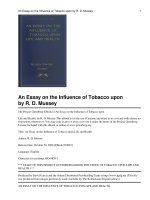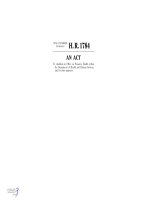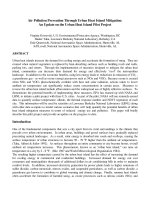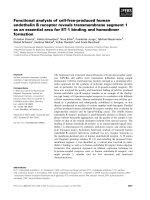Cell phones and human health an update on research and regulations
Bạn đang xem bản rút gọn của tài liệu. Xem và tải ngay bản đầy đủ của tài liệu tại đây (452.77 KB, 43 trang )
Cell Phones and Human Health:
An Update on Research and
Regulations
Presented at AIHCE
June 6, 2001
Marty Eroh, CIH
Pinnacle West Corporation
Cell Phone - Background
✔ Use of cell phones has grown dramatically over the
last fifteen years.
✔ Operate at frequencies slightly higher than TV and
FM Radio signals (Nonionizing).
✔ Analog and digital phones operate in the frequency
range of 900 - 1800 MHz.
✔ The maximum powers of these phones are 2W and
1W (900 and 1800 MHz respectively). Average
power are 1/8 of maximum.
EM Spectrum
Humans are Exposed to Broad Range of
Electromagnetic Frequencies
Nonionizing Radiation
1
Hz
10
Hz
100
Hz
1
kHz
10
kHz
Ionizing Radiation
12
100
1
1
10
100
10
100
kHz MHz MHz MHz GHz GHz GHz
10
Hz
13
10
Hz
14
10
Hz
15
10
Hz
16
10
Hz
17
10
Hz
18
10
Hz
19
10
Hz
20
10
Hz
21
10
Hz
Frequency
Electric
power
Radio
Infrared
Microwave
}
Extra-low
frequency
(ELF)
Ultra-violet
X-rays,
gamma rays
Visible light
Video
display
terminals
AM
radio
FM radio,
VHF TV
UHF TV,
cellular
telephones
Microwave
ovens, police
radar,
satellite
stations
Heat
lamps
Sun
lamps
22
10
Hz
Basic Operation
✔ Mobile phones communicate with base stations
(fixed installations).
✔ Base stations have limited range, therefore requires a
nationwide network.
– Macrocells - up to about 22 miles, power output in
tens of watts.
– Microcells - infill, airports, railway stations.
Range of few hundred yards.
– Picocells - Sited inside buildings. Low power.
Sources of Exposure
✔ Mobile phones and base stations - exposures
reduce with distance from the source.
✔ Mobile phones - principal exposure is to the side
of the head for hand held, or to other body parts
during hands free use.
✔ Base station exposure is whole body, but much
lower intensity than from handsets.
Typical and Atypical Base
Stations
Typical and Atypical Base
Stations
Typical and Atypical Base
Stations
Typical and Atypical Base
Stations
Typical and Atypical Base
Stations
Typical and Atypical Base
Stations
Current Basis of Exposure
Guidelines
✔ Primary sources of exposure guidelines, including
IEEE, ICNIRP, NRPB are all based on avoiding
thermal effects.
✔ Some variation in the limits, e.g. some limits build
in a safety factor for the general public vs workers.
Exposure Limits (cont.)
✔ Most exposure limits are now provided in two
forms:
– Basic Restrictions - based on SAR - difficult to
measure.
– Reference or Investigation Levels - based on
field strengths (v/m, A/m, or W/m2), more easily
measured.
✔ Can exceed the reference levels as long as the basic
restrictions are not exceeded.
Example of ICNIRP Guidelines
✔ Basic restrictions
✔ Reference level for
✔ Whole Body SAR = 0.4
general public at cell
phone frequency
✔ 1800 - 1900 MHz = 9
- 9.5 W/m2 (based on
f in MHz/200)
(0.08) W/kg averaged
over 6 minutes.
✔ Head / trunk SAR = 10
(2) W/kg based on 10
grams of mass and 6
minute average.
✔ ( ) denotes public.
Are there Non-thermal Effects?
✔ Is there justification for standards below thermal
limits?
✔ Do biological effects = adverse health effects?
✔ What areas of research deserve attention?
✔ What approach should be taken while research is
being completed?
IEGMP
✔ Independent Expert Group on Mobile Phones
report from Great Britain, April 2000.
✔ Good overall summary of the science to date.
✔ Review this report and a few more recent
publications.
IEGMP Overall Conclusions
✔ Despite widespread use, there is little research
specifically relevant to cell phones.
✔ The balance of evidence to date suggests that there
are no adverse health effects below current
ICNIRP guidelines (only thermal effects).
✔ Some evidence for biological activity below the
guidelines, but not clear that they lead to disease.
IEGMP Overall Conclusions
(Cont.)
✔ Not possible to say that exposures below
guidelines are totally without potential adverse
health effects; knowledge gaps justify
precautionary approach.
✔ Due to well-documented detrimental effects
drivers should be dissuaded from using either
hand-held or hands-free phones while on the
move.
Biological Interaction
✔ Force produced by an electric field on charged
objects (ions in the body) causes them to move,
results in electric currents. Currents flowing
through resistance of the material results in
heating. Heat input causes increased blood flow
for heat dissipation (equilibrium).
✔ Increase in brain temp by cell phones is estimated
to be 0.1 C (to equilibrium).
Biological Interaction
✔ The energy quanta at cell phone frequencies is 4 -
7 micro eV (millionth of eV). Energy needed to
break chemical bonds in DNA is 1 eV.
Insufficient power to break bonds.
✔ Electric field created in biological tissue. But to
produce detectable changes, these fields would
need to be greater than thermal or random noise.
Potential Biological Interaction
✔ Could fields induce cell polarization?
✔ Could fields affect movement of ions through cell
membrane channels?
✔ Does it increase ODC Activity?
✔ Do fields effect gene expression?
✔ Others?
✔ If any of these effects are real, do they result in an
adverse health outcome?
Epidemiologic Evidence
✔ Few studies directly examining cell phones and
health effects.
✔ Latency of certain diseases, changes in
technology, and changes in usage patterns, is an
overall weakness in cell phone epidemiology.
Two Recent Hospital Based
Case-Control Studies
✔ Muscat et al., JAMA 2000; 284:3001-7
✔ Inskip et al., NEJM, 2001;344: 79-86
✔ 469 and 782 cases of brain CA respectively.
✔ Controls were either benign disorders or cancers
other than lymphoma and leukemia.
✔ Exposure assessment through questionnaire.
– Duration and frequency of use.
– Type of phone, handedness
Results of Muscat and Inskip
✔ No association between measures of cell phone
use and risk of brain cancer (total, site specific, or
by histological type).
✔ Limitations
– Exposure assessment (questionnaire)
– No measurements
– Low usage / short latency
– Hospital controls
Cohort Study in Denmark
✔ Johansen et al., Journal of the NCI, 2001
✔ Nationwide cohort study of cell phone users.
✔ Linked to Danish cancer registry.
✔ Standardized Incidence Ratios (SIR) - observed to
expected.









